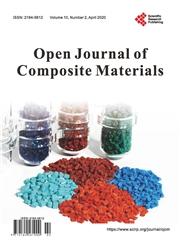Towards Reliability-Enhanced Mechanical Characterization of Non-Crimp Fabrics: How to Compare Two Force-Displacement Curves against a Null Material Hypothesis
引用次数: 1
Abstract
Detailed characterization of fabric reinforcements is necessary to ensure the quality of manufactured composite parts, and subsequently to prevent structural failure during service. A lack of consensus and standardization exists in selecting test methods for the mechanical characterization of fabrics. Moreover, in reality, during any experimentation there are sources of uncertainties which may result in inconsistencies in the interpretation of data and the comparison of different testing methods. The aim of this article is to show how simple statistical data analysis methods may be used to enhance the characterization of composite fabrics under individual and combined loading modes while accounting for inherent material/test uncertainties. Results using a typical glass non-crimp fabric (NCF) show that, statistically, there are significant differences between the warp and weft direction responses of a presumably balanced NCF under all deformation modes, with weft yarns being generally stiffer. Moreover, the statistical significance of warp-weft couplings under both simultaneous and sequential biaxial-shear loading modes became statistically evident, when compared to a pure biaxial deformation.迈向无卷曲织物的可靠性增强力学特性:如何比较两种力-位移曲线与零材料假设
织物增强材料的详细特性对于确保制造的复合材料零件的质量以及防止使用过程中的结构故障是必要的。在选择织物机械特性的测试方法方面缺乏共识和标准化。此外,事实上,在任何实验过程中,都存在不确定性来源,这可能导致数据解释和不同测试方法的比较不一致。本文的目的是展示如何使用简单的统计数据分析方法来增强复合织物在单独和组合载荷模式下的特性,同时考虑固有的材料/测试不确定性。使用典型的玻璃无卷曲织物(NCF)的结果表明,从统计上看,在所有变形模式下,假定平衡的NCF的经纱和纬纱方向响应之间存在显著差异,纬纱通常更硬。此外,与纯双轴变形相比,在同时和连续双轴剪切加载模式下,经纬耦合的统计显著性在统计学上变得明显。
本文章由计算机程序翻译,如有差异,请以英文原文为准。
求助全文
约1分钟内获得全文
求助全文

 求助内容:
求助内容: 应助结果提醒方式:
应助结果提醒方式:


